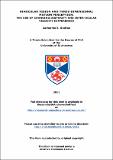Files in this item
Binocular vision and three-dimensional motion perception : the use of changing disparity and inter-ocular velocity differences
Item metadata
| dc.contributor.advisor | Harris, Julie | |
| dc.contributor.author | Grafton, Catherine E. | |
| dc.coverage.spatial | 362 | en_US |
| dc.date.accessioned | 2011-07-19T14:20:11Z | |
| dc.date.available | 2011-07-19T14:20:11Z | |
| dc.date.issued | 2011-06-22 | |
| dc.identifier | uk.bl.ethos.552571 | |
| dc.identifier.uri | https://hdl.handle.net/10023/1922 | |
| dc.description.abstract | This thesis investigates the use of binocular information for motion-in-depth (MID) perception. There are at least two different types of binocular information available to the visual system from which to derive a perception of MID: changing disparity (CD) and inter-ocular velocity differences (IOVD). In the following experiments, we manipulate the availability of CD and IOVD information in order to assess the relative influence of each on MID judgements. In the first experiment, we assessed the relative effectiveness of CD and IOVD information for MID detection, and whether the two types of binocular information are processed by separate mechanisms with differing characteristics. Our results suggest that, both CD and IOVD information can be utilised for MID detection, yet, the relative dependence on either of these types of MID information varies between observers. We then went on to explore the contribution of CD and IOVD information to time-to-contact (TTC) perception, whereby an observer judges the time at which an approaching stimulus will contact them. We confirmed that the addition of congruent binocular information to looming stimuli can influence TTC judgements, but that there is no influence from binocular information indicating no motion. Further to this, we found that observers could utilise both CD and IOVD for TTC judgements, although once again, individual receptiveness to CD and/or IOVD information varied. Thus, we demonstrate that the human visual system is able to process both CD and IOVD information, but the influence of either (or both) of these cues on an individual’s perception has been shown to be mutually independent. | en_US |
| dc.language.iso | en | en_US |
| dc.publisher | University of St Andrews | |
| dc.rights | Creative Commons Attribution-NonCommercial-NoDerivs 3.0 Unported | |
| dc.rights.uri | http://creativecommons.org/licenses/by-nc-nd/3.0/ | |
| dc.subject | Binocular vision | en_US |
| dc.subject | Motion-in-depth | en_US |
| dc.subject | Changing disparity | en_US |
| dc.subject | Inter-ocular velocity differences | en_US |
| dc.subject | Time-to-contact | en_US |
| dc.subject | Vision science | en_US |
| dc.subject | Visual perception | en_US |
| dc.subject.lcc | BF245.G8 | |
| dc.subject.lcsh | Motion perception (Vision) | en_US |
| dc.subject.lcsh | Binocular vision | en_US |
| dc.title | Binocular vision and three-dimensional motion perception : the use of changing disparity and inter-ocular velocity differences | en_US |
| dc.type | Thesis | en_US |
| dc.contributor.sponsor | Engineering and Physical Sciences Research Council (EPSRC) | en_US |
| dc.type.qualificationlevel | Doctoral | en_US |
| dc.type.qualificationname | PhD Doctor of Philosophy | en_US |
| dc.publisher.institution | The University of St Andrews | en_US |
| dc.publisher.department | School of Psychology | en_US |
This item appears in the following Collection(s)
Except where otherwise noted within the work, this item's licence for re-use is described as Creative Commons Attribution-NonCommercial-NoDerivs 3.0 Unported
Items in the St Andrews Research Repository are protected by copyright, with all rights reserved, unless otherwise indicated.


